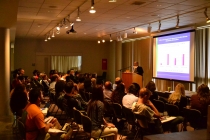On Friday, the Albin O. Kuhn Library Gallery was home to a presentation on research on mental health disparities. As a part of their Social Science Forum, the panel was comprised of three guest lecturers from colleges around the country.
Marta Elliott, professor of sociology at University of Nevada, Reno, was the first to lecture. Her talk was based around mental health disparities among men and women, and specifically issues that affected men differently than they affected women. A large focus was placed on gender-typed stressors and stress-inducers that differ between genders.
Her research concluded that men were more likely to become substance abusers. Women, however, had higher rates of internalized depression and anxiety.
Following Elliott was Dawne Mouzon from Rutgers University and a presentation on the “Black-White Paradox” in mental health. Her studies showed that black Americans, despite having poorer physical health on average, had better mental health than their white counterparts.
Although her research showed that health increased in conjunction with socioeconomic status, her findings nonetheless revealed lower rates of psychiatric disorders among black Americans. Her data was thus consistent with the paradox.
Lastly, Michael Hughes from Virginia Tech presented his findings on racial identity and mental health. His data seemed to be consistent with that Mouzon had found.
The lectures had quite the turnout, with people even standing as all the seats were full. Among the crowd of students was Pamela Rakshan, a graduate student studying clinical psychology. As a psychology student working in a lab on campus, Rakshan’s interest was already piqued by the event.
“Topics about mental illness are my field of interest. I think it is important to understand disparities in mental health, as well as how the field of mental health research conceptualizes gender and race differences,” said Rakshan.
Such an event being held at UMBC was a great advance, said Rakshan. “It is always exciting to see the products of collaboration between researchers, and I’m so happy that UMBC is a place where interesting collaborative research is being performed and presented,” said Rakshan.
In terms of its effect on UMBC as a community, Rakshan felt that the event was unparalleled in its ability to educate.
“Understanding diversity and how an individual’s unique perspective influence their strengths and symptoms is key to our work,” said Rakshan.

